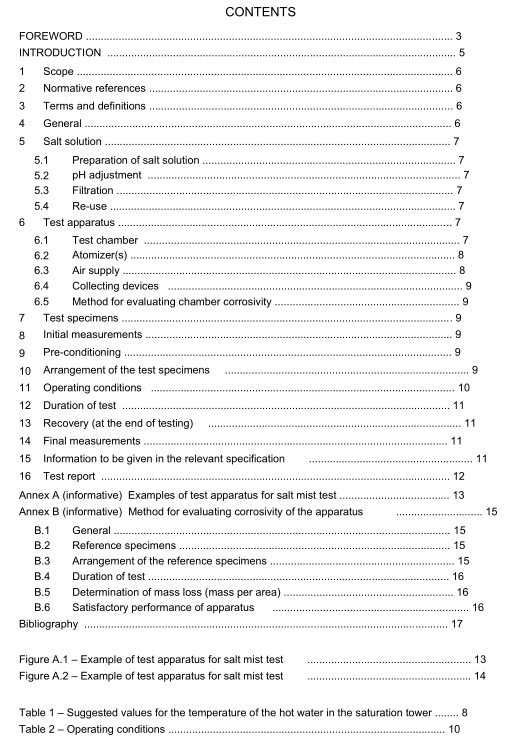IEC 60068-2-11 pdf – Environmental testing – Part 2-11: Tests – Test Ka: Salt mist

IEC 60068-2-11 pdf – Environmental testing – Part 2-11: Tests – Test Ka: Salt mist
1 Scope
This part of lEC 60068 specifies a test method for assessing the corrosion resistance ofelectrotechnical products components, equipment and materials in a salt mist environment. lts
objective is to verify that the comparative quality of a metallic material,with or withoutcorrosion protection, is maintained when exposed to salt mist.
This test method is useful for evaluating the quality and the uniformity of coatings applied toprotect metals against corrosion. It is particularly useful for detecting discontinuities, such aspores and other defects, in certain metallic, organic,anodic oxide and conversion coatings.
2Normative references
The following documents are referred to in the text in such a way that some or all of theircontent constitutes requirements of this document. For dated references,only the editioncited applies. For undated references, the latest edition of the referenced document (including
any amendments) applies.
IEC 60068-1,Environmental testing – Part 1: General and guidance
3 Terms and definitions
No terms and definitions are listed in this document.
IsO and IEC maintain terminological databases for use in standardization at the followingaddresses:
. IEC Electropedia: available at http://www.electropedia.orgl
. Iso Online browsing platform: available at http://www.iso.org/obp
4General
WARNING – This document can involve hazardous materials, operations and equipment. This
document does not purport to address all of the safety concerns,if any,associated with itsuse. It is the responsibility of the user of this document to establish appropriate safety andhealth practices and determine the applicability of regulatory limitations prior to use.
For equipment and components,Test Kb (IEC 60068-2-52)is considered to provide morerealistic conditions and to provide means of assessment of individual items. lf, however,forparticular circumstances, the relevant specification requires this test(Ka) to be applied toindividual specimens for qualification purposes,then the specimens should be tested as partof the overall assembly or equipment in which they are to be used and be completed with any
protection devices (cases, covers, shields, etc.), as in practice.
NOTE 1 “Salt mist” is also called “salt spray”.
NOTE 2The test specimen(s) is typically not energized during the test.
5 Salt solution
5.1 Preparation of salt solution
Dissolve a sufficient mass of sodium chloride in distilled or deionized water with a conductivity
not higher than 20 uS/cm at 25 °C±2K to produce a concentration of 50 gl ± 5 gl. Thesodium chloride concentration of the sprayed solution collected shall be 50g/l: 5 gl. Thespecific gravity range for a 50 g/l± 5 gl solution is 1,029 to 1,036 at 25 °℃.
The sodium chloride shall not contain a mass fraction of the heavy metals copper (Cu), nickel
(Ni) and lead (Pb) in total more than 0,005 %. lt shall not contain a mass fraction of sodiumiodide more than 0,1 % and a mass fraction of total impurities more than 0,5 %, calculated for
dry salt.
NOTESodum chloride with ant-caking _agents can act as corrosion inhlbitors or accelerators. A usaful sodiumchliaride salt grade is a grade named Ph. EurusPor JIS,ACS.
5.2pH adjustment
lf necessary, adjust the pH of the salt solution so that the pH of the sprayed solution collected
within the test chamber is 6,5 to 7,2 at 25 “C±2K. Check the pH using electrometricmeasurement Measurements of pH shall be done using electrodes suitable for measuring inweakly buffered sodium chloride solution in deionized water.
Make any necessary corrections by adding hydrochloric acid,sodium hydroxide or sodiumbicarbonate solution of analytical grade.
WARNING – Hydrochloricacid (CAS no.7647-01-0) solution is toxic,corrosive,irritating andvery toxic to aquatic life.Handling of hydrochloric acid solution shall be restricted to skilledpersonnel or conducted under their control. Care shall be taken in the disposal of this solution.
WARNING – Sodium hydroxide(CAS no.1310-73-2) solution is toxic, corrosive and iritating.
Handling of sodium hydroxide solution shall be restricted to skilled personnel or conductedunder their control. Care shall be taken in the disposal of this solution.
NOTEPossible changes in pH can resuli from loss of carbon dioxide in the solution when it is sprayed. Suchchanges can be avoided by reducing the carbon dioxide content of the solution by, for example, heating it to atemperature abowe 35“C before it is placed in the apparatus,or by making the solution using freshly bolled water.
The pH shall be measured when preparing each new batch of solution.
5.3 Filtration
lf necessary,filter the solution before placing it in the reservoir of the apparatus,to removeany solid matter which might block the apertures of the spraying device,
5.4 Re-use
The sprayed solution shall not be re-used.
6Test apparatus
6.1 Test chamber
The chamber for this test shall be constructed of such materials that will not influence thecorrosive effects of the salt mist.









